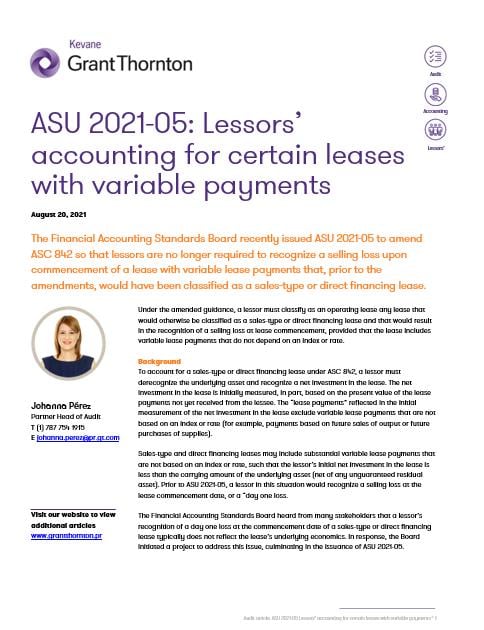-
Financial statements audits
Financial statement audits
-
Compliance audits
Compliance audits
-
Compilations and reviews
Compilations and audit
-
Agreed-upon procedures
Agreed-upon procedures
-
Corporate and business tax
Our trusted teams can prepare corporate tax files and ruling requests, support you with deferrals, accounting procedures and legitimate tax benefits.
-
International tax
Our teams have in-depth knowledge of the relationship between domestic and international tax laws.
-
Tax compliance
Business Tax
-
Individual taxes
Individual taxes
-
Estate and succession planning
Estate and succession planning
-
Global mobility services
Through our global organisation of member firms, we support both companies and individuals, providing insightful solutions to minimise the tax burden for both parties.
-
Sales and use tax and indirect taxes
SUT/ VAT & indirect taxes
-
Tax incentives program
Tax incentives program
-
Transfer Pricing Study
The laws surrounding transfer pricing are becoming ever more complex, as tax affairs of multinational companies are facing scrutiny from media, regulators and the public

-
Business consulting
Our business consulting services can help you improve your operational performance and productivity, adding value throughout your growth life cycle.
-
Forensic and investigative services
At Grant Thornton, we have a wealth of knowledge in forensic services and can support you with issues such as dispute resolution, fraud and insurance claims.
-
Fraud and investigations
The commercial landscape is changing fast. An ever more regulated environment means organizations today must adopt stringent governance and compliance processes. As business has become global, organizations need to adapt to deal with multi-jurisdictional investigations, litigation, and dispute resolution, address the threat of cyber-attack and at the same time protect the organization’s value.
-
Dispute resolutions
Our independent experts are experienced in advising on civil and criminal matters involving contract breaches, partnership disputes, auditor negligence, shareholder disputes and company valuations, disputes for corporates, the public sector and individuals. We act in all forms of dispute resolution, including litigation, arbitration, and mediation.
-
Business risk services
We can help you identify, understand and manage potential risks to safeguard your business and comply with regulatory requirements.
-
Internal audit
We work with our clients to assess their corporate level risk, identify areas of greatest risk and develop appropriate work plans and audit programs to mitigate these risks.
-
Service organization reports
As a service organization, you know how important it is to produce a report for your customers and their auditors that instills confidence and enhances their trust in your services. Grant Thornton Advisory professionals can help you determine which report(s) will satisfy your customers’ needs and provide relevant information to your customers and customers’ auditors that will be a business benefit to you.
-
Transactional advisory services
Transactions are significant events in the life of a business – a successful deal that can have a lasting impact on the future shape of the organizations involved. Because the stakes are high for both buyers and sellers, experience, determination and pragmatism are required to bring deals safely through to conclusion.
-
Mergers and acquisitions
Globalization and company growth ambitions are driving an increase in M&A activity worldwide as businesses look to establish a footprint in countries beyond their own. Even within their own regions, many businesses feel the pressure to acquire in order to establish a strategic presence in new markets, such as those being created by rapid technological innovation.
-
Valuations
We can support you throughout the transaction process – helping achieve the best possible outcome at the point of the transaction and in the longer term.
-
Recovery and reorganization
We provide a wide range of services to recovery and reorganisation professionals, companies and their stakeholders.
Under the amended guidance, a lessor must classify as an operating lease any lease that would otherwise be classified as a sales-type or direct financing lease and that would result in the recognition of a selling loss at lease commencement, provided that the lease includes variable lease payments that do not depend on an index or rate.
Background
To account for a sales-type or direct financing lease under ASC 842, a lessor must derecognize the underlying asset and recognize a net investment in the lease. The net investment in the lease is initially measured, in part, based on the present value of the lease payments not yet received from the lessee. The “lease payments” reflected in the initial measurement of the net investment in the lease exclude variable lease payments that are not based on an index or rate (for example, payments based on future sales of output or future purchases of supplies).
Sales-type and direct financing leases may include substantial variable lease payments that are not based on an index or rate, such that the lessor’s initial net investment in the lease is less than the carrying amount of the underlying asset (net of any unguaranteed residual asset). Prior to ASU 2021-05, a lessor in this situation would recognize a selling loss at the lease commencement date, or a “day one loss.
The Financial Accounting Standards Board heard from many stakeholders that a lessor’s recognition of a day one loss at the commencement date of a sales-type or direct financing lease typically does not reflect the lease’s underlying economics. In response, the Board initiated a project to address this issue, culminating in the issuance of ASU 2021-05.
Amendments to ASC 842
ASU 2021-05 amends the lessor lease classification guidance in ASC 842 for leases that include any amount of variable lease payments that are not based on an index or rate.
If such a lease meets the criteria in ASC 842-10-25-2 through 25-3 for classification as either a sales-type or direct financing lease, and application of the sales-type or direct financing lease recognition guidance would result in recognition of a selling loss, then the amendments require the lessor to classify the lease as an operating lease.
Accounting for affected leases
Under ASC 842, for operating leases a lessor neither derecognizes the underlying asset nor recognizes a net investment in the lease, and instead recognizes the “lease payments” on a straight-line basis over the lease term. Variable lease payments not based on an index or rate are excluded from the “lease payments” at commencement and are instead recognized in the period when the changes in facts and circumstances on which the variable lease payments are based occur.
For leases classified as operating leases under the amended guidance, a lessor does not recognize a day one loss that would have been recognized if the lease were classified as a sales-type or direct financing lease.
Effective date
For public business entities and certain not-for-profit entities and employee benefit plans that have adopted ASC 842 as of July 19, 2021, the amendments in ASU 2021-05 are effective for fiscal years beginning after Dec 15, 2021, and for interim periods within those fiscal years.
For all other entities that have adopted ASC 842 as of July 19, 2021, the amendments in ASU 2021-05 are effective for fiscal years beginning after Dec 15, 2021, and for interim periods within fiscal years beginning after Dec 15, 2022.
All entities that have adopted ASC 842 as of July 19, 2021, are permitted to early adopt the amendments in ASU 2021-05.
The amendments in ASU 2021-05 are effective as of the same date as the guidance in ASC 842 for entities that have not adopted ASC 842 as of July 19, 2021.
Transition
Entities that have adopted ASC 842 as of July 19, 2021, may use either of the following transition methods:
- retrospective application to leases that commenced or were modified (except for modifications that meet the conditions in ASC 842-10-25-8) after the beginning of the period in which ASC 842 was adopted
- prospective application to leases that commence or are modified (except for modifications that meet the conditions in ASC 842-10-25-8) subsequent to the date the amendments in ASU 2021-05 are first applied (that is, no earlier than July 19, 2021)
Entities that apply the retrospective transition method must disclose the applicable transition information required by ASC 250, except for the requirements in ASC 250-10-50-1(b)(2) and ASC 250-10-50-3. The cumulative effect of applying the amendments in ASU 2021-05 on retained earnings or other components of equity or net assets must be disclosed as of the beginning of the earliest period presented, but not before the date when ASC 842 was adopted.
Entities that apply the prospective transition method must disclose the following information:
- the nature of, and reason for, the change in accounting principle
- the transition method
- a qualitative description of the financial statement line items affected by the change
For entities that have not adopted ASC 842 as of July 19, 2021, the amendments in ASU 2021-05 are subject to the same transition guidance that applies to ASC 842.
Source: Grant Thornton Snapshot July 22, 2021
We are committed to keeping you up to date of all developments that may affect the way you do business in Puerto Rico. Please contact us for further assistance in relation to this or any other matter.
